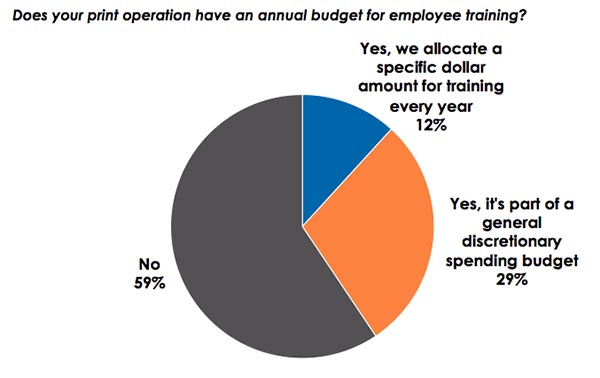- When a valuable employee leaves a business, this can result in a shortage of institutional knowledge, lower morale among remaining team members, and lost productivity.
- Rather than encouraging employees to seek greener pastures, providing a continuum for personal growth and professional development can increase engagement, raise productivity, and foster a higher level of job satisfaction.
- In some cases, obtaining training services from third party/external resources can be the best way to ensure that all employees receive adequate training.
By Karen Kimerer
Introduction
Employee training isn’t something that is just nice to have in an organization—it is completely vital to any company’s long-term investment and growth strategy. Everyone knows that a firm’s employees are its most valuable assets. Investing in your employees and helping them reach their full potential at work can directly affect the overall productivity and profitability of your business.
Regardless of industry or market focus, employee retention is a top-of-mind issue for nearly every organization. According to the U.S. Bureau of Labor Statistics, about 3 million Americans quit their jobs each month. When a valuable employee leaves a business, this can result in a shortage of institutional knowledge, lower morale among remaining team members, and lost productivity. On the other hand, proper training can improve employee retention and increase company growth.
Training Programs Can Improve Employee Retention
Adequate training is key to keeping employees engaged and loyal to their organizations. Unfortunately, it is not uncommon for some firms to shy away from training investments out of fear that they will only strengthen their employees’ skill sets for future jobs. These concerns should not deter a company from helping all employees reach their full potential. Rather than encouraging employees to seek greener pastures, providing a continuum for personal growth and professional development can increase engagement, raise productivity, and foster a higher level of job satisfaction.
Our industry is changing all the time, and this is particularly true today amid growing concerns about the coronavirus (COVID-19). The skills that your employees require are shifting as a result of these changes, and it’s important to be aware of them and adjust your training practices accordingly. The benefits of quality training are clear. The cost of retaining existing employees is far less than the cost of replacing them, and happy employees by their nature are generally more likely to deliver greater customer service. Satisfied customers will keep coming back for more, and this will ultimately increase your company’s overall growth.
A recent study from Keypoint Intelligence – InfoTrends surveyed PSPs to understand the actions that growing print-for-pay and in-plant printing firms are taking to develop, improve, and market their businesses. Although the benefits of training programs may seem obvious, most of the PSPs that InfoTrends surveyed don’t have an annual training budget.
Budget for Employee Training

N = 212 Print Service Providers
Source: Winning in an Evolving Print Services Market; Keypoint Intelligence – InfoTrends 2018
Although most PSPs do not budget for employee training, they do seem to recognize the value of training. According to the same survey, 77% of print-for-pay respondents and 63% of in-plant respondents devote them to training their employees themselves. So while it is well-understood that training can add value to an organization, it may be more important to assess the type of training that is required and how it should be delivered.
In the end, the goal of any training regimen is to improve employee performance and skill set. This training can come in many forms, but some of the most common types of training within the printing industry include:
- Executive development
- Manager or supervisor training
- Systems (workflow and software) training
- Application or production training
- Customer service training
- Compliance training
- Industry-specific training
- Onboarding/new employee training
- Sales training
In some cases, obtaining training services from third party/external resources can be the best way to ensure that all employees receive adequate training. Relying on third parties may be necessary in today’s challenging climate; many organizations have already implemented temporary work from home policies to protect their employees and their families from COVID-19. Should these policies remain in effect for the long term, businesses may need to rely on an increased amount of virtual training so employees can continue to work effectively from remote locations. According to InfoTrends’ research, high-growth PSPs place a greater emphasis on color management, sales process/strategy, and business improvement strategy training. On the other hand, declining PSPs are more likely to focus on marketing strategies training. Software training was common among all PSPs, regardless of growth trajectory.
The Bottom Line
If you haven’t set aside a budget for employee training, now is the time! If the thought of training is daunting, start small by focusing on the factors that will have the greatest impact on your business growth. You might also consider a micro-learning approach to jump-start your training implementation and strategy. This can be a great way to improve and advance critical needs while still enabling your employees to remain productive in their day-to-day responsibilities. Formal training and development can also be fostered with a blended learning approach—some of your employees might learn better in a classroom environment, while others might be more aligned with podcasts or video instruction. Finally, don’t be afraid to rely on external experts, especially if you’ve recently implemented work from home policies because of COVID-19. In these uncertain times, all PSPs should rethink their employee training strategies. Ongoing and relevant training is paramount to employee retention, competitive differentiation, and business growth!
Karen Kimerer, Director of InfoTrends’ Business Development Strategies consulting service, has experienced the many challenges of expanding current market opportunities and securing new business. She has developed a systematic approach to these opportunities, addressing the unique requirements of becoming a leader in our changing industry. She is well-versed in 1:1 marketing, web-to-print, direct mail, book publishing, supply chain management, data segmentation, channel integration, and photo products.














